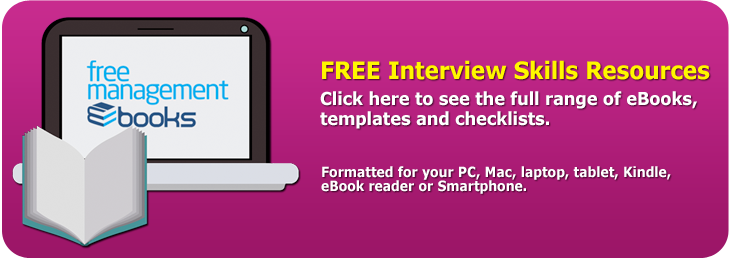SOARA Method
This method is slightly more involved than the STAR method and some people may prefer using it, particularly if they have a lot of management experience from which to draw examples.
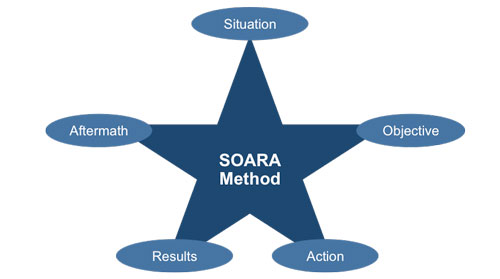 |
The SOARA method:
1) Identify a Situation that enables you to illustrate how you behaved in that recent event, giving particular emphasis to describing the required competency the question is aimed at assessing.
2) State the Objective you wanted to attain by the conclusion of this situation or event.
3) Describe what Action you took to achieve your objective. Your actions and behaviors must reflect those of someone who is performing the role. This is most easily shown in your reasoning for doing what you did and how you assessed alternatives.
4) Make sure you clearly state the Results of your decisions and actions as well as how you attained your objective.
5) Conclude your answer with a summary of what you learnt from this situation and how this has influenced you since. This is referred to as the Aftermath.
In this example we show you how Helena, a project consultant with twelve years' experience, including five years in a management role, prepares for a management assessment for the senior position.
From the documents she has been sent and her own research she has discovered that 'strategic thinking' is an essential competency. There are four behavioral aspects to this competency:
1) Aware of and understands the organization's strategic objectives.
2) Regularly reviews the 'market place' from a strategic viewpoint and its potential impact on the organization.
3) Analyzes the strategic stance of competitors.
4) Educates and leads others in their understanding of how they contribute to the organization's objectives.
Using this definition and the list of behaviors from the management competency framework, Helena is able to create the following table. The left column lists each behavior for this competency and in the right column she writes a potential competency-based question.
Some of the questions created may seem a bit contrived and therefore unlikely to be asked in the interview. This is something that can only be judged on a case-by-case basis after reading the job ad, specification, and description for a particular role. It is also true that some competencies are more likely to be assessed using a management exercise or by direct observation, rather than by an interview question.
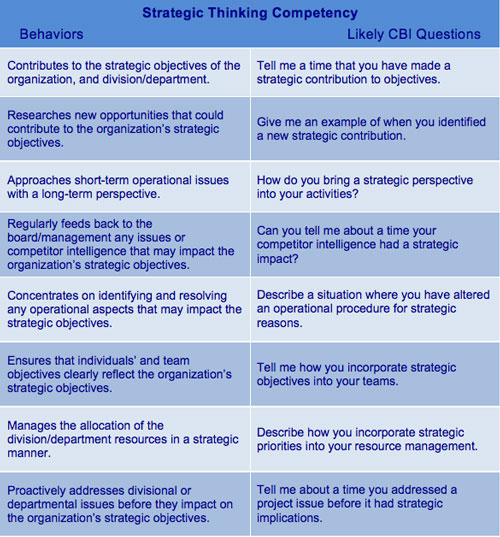 |
To make it easier to identify the best events and challenges Helena has quickly created a 'situation mind map' from her work experiences and personal achievements. This visual representation of her resume will be copied and completed for each competency required in the role. In this example it is for 'strategic thinking.'
All CBI questions are looking for recent examples of how you met a challenge or events that illustrate a desired competency, so early work experiences are excluded because their level of any competencies has been superseded.
For Helena this means that she focuses on the projects she has managed over the last five years and non-work activities that could be used to illustrate the management level of a competency.
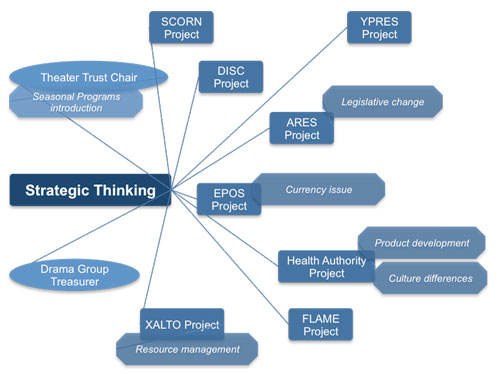 |
This mind map shows the five projects that enable her to illustrate strategic thinking. The table below shows how she uses SOARA to prepare an answer to the selected question.
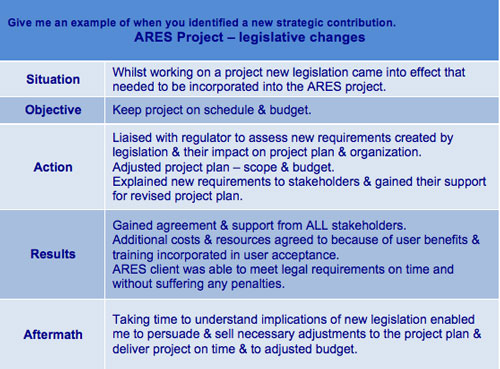 |
Normally the situation Helena faced in the ARES project would have caused considerable problems at both an operational level with the project team and strategic level with stakeholders. By taking time to understand the differences brought about by the new legislation and their strategic implications for the organization she was able to gain the support and approval of the stakeholders for the necessary amendments to the project plan.
In answering this question she could also cite how it helped her to use knowledge of the market and environment that an organization operated in to gain cultural acceptance of changes to working practices in the Health Authority and the currency issue in the EPOS project.
The next example shows how Helena used a non-work experience to answer another CBI question for this competency. She was able to transform the production decision-making process from an operational one (a responsibility of the production team) to a strategic one regularly discussed by the Trust's Steering Committee (TSC) of which she was Chair.
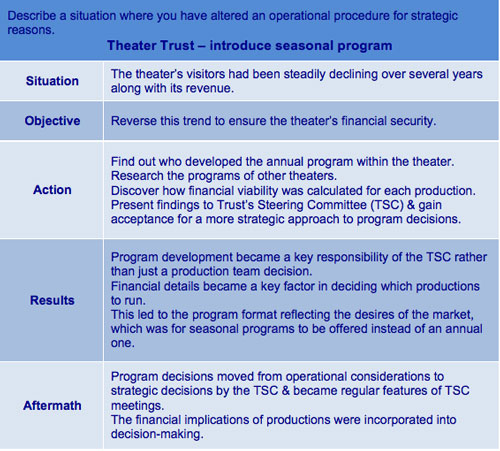 |
This answer illustrates that through knowledge gained from research she was able to persuade the TSC of the strategic importance of production planning and ensure that market desires and financial viability of productions formed a key part of such decisions.
This process is similar to the STAR method explained earlier in that it is time consuming and takes a lot of work. This is best done over a period of a few days, tackling one competency at a time and revising previous items as better examples occur to you.
Because most of the competencies you will be asked questions about will be similar, provided that you are applying for the same type of job you don't usually need to make frequent changes to this information, although you may need to update it following a significant event.
If you are going to succeed in a competency-based interview then your answers must:
• Be specific in their description and detail
• Be concise and highlight your achievements clearly
• Show your actions were structured
• Convey the maximum achievement in the minimum time
• Give a strong and positive impression at the end of your answer
• Show what you learnt from the situation.
Your answers need to convey that you use a variety of competencies to achieve your objectives and draw attention to the key aspects of your resume in relation to the role. You also need to avoid using the same examples again and again.
The mind maps and other documents that you create using the STAR and SOARA methods enable you to do all of these things. This can really help with self-confidence, which is a big factor in interview success, provided that you are being realistic about the role you are applying for.
You may also be interested in:
Competency Based Interviews | Competency-Based Questions | STAR Method | SOARA Method.

